Western European economy 1000–1250
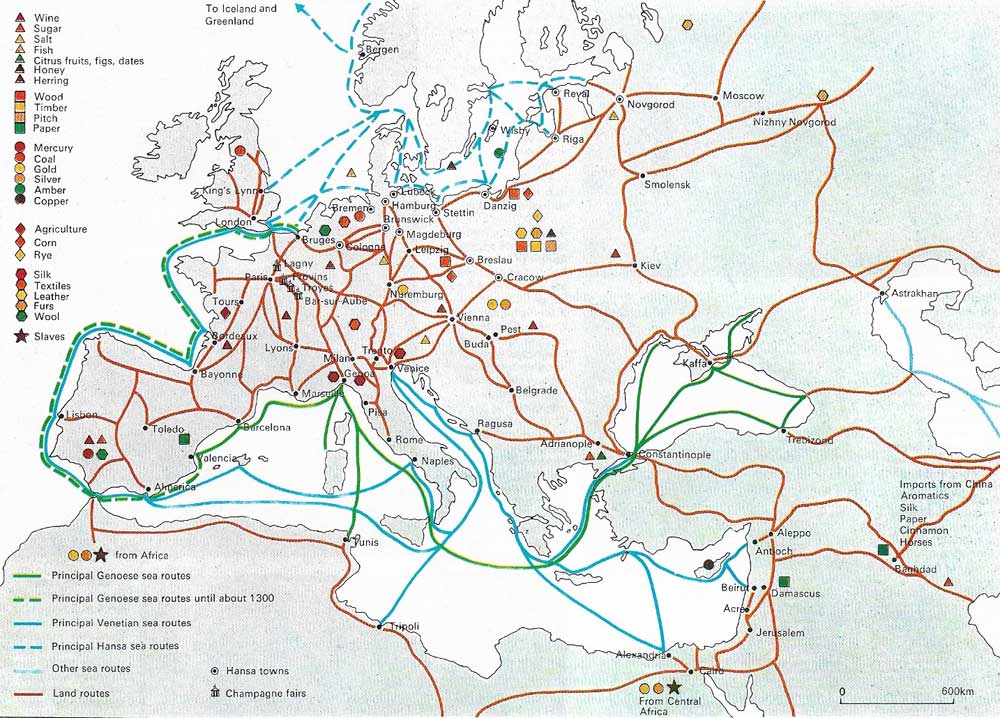
Figure 1. The number of trade routes, by both land and sea, increased during the High Middle Ages. The most popular form of bulk transport in the early Middle Ages was by river. In the 11th and 12th centuries land transport became much easier, partly because the routes were safer, partly because of the increased use of pack animals. The trade of the carrier, often a native of the high Alps, had by 1250 become an integral link in Italian commerce with northern Europe. The routes primarily linked importing centers such as the Italian and Hansa towns with the centers of production and exchange – the fairs of northern Europe and Flemish towns. But links were also forged through Poland and Hungary with the ancient Asiatic routes. Sea routes developed dramatically during the 12th century. Mediterranean ships of the period were small, rarely more than 100 tons. They usually sailed in convoy and with enterprising crews from Venice. Pisa, and Genoa to most Mediterranean ports. Some Levant towns had Italian quarters as early as 1110. Subsequently the Venetians established themselves at Alexandria and their attempts to control the trade of Constantinople culminated in their conquest of that city in 1204. The northern seas had their own Viking tradition of seamanship. The trade in furs originally carried by Scandinavians from Novgorod to the Baltic fell into the hands of merchants from the north German towns in the 12th century. The merchants soon organized themselves into a protective league or Hansa.
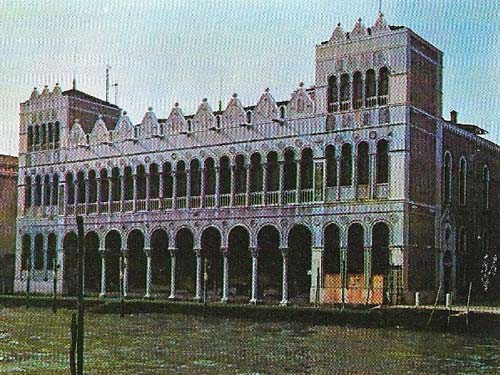
Figure 2. The Fondaco dei Turchi (Turkish warehouse) on the Grand Canal in Venice was built on the late Romanesque style on the 13th century. Although it takes its name from a later period of the city’s mercantile development, the building exemplifies Venetian power in the first era of its commercial success. From the 11th century, Venice dominated European trade with the East and its arsenal and dockyard comprised the biggest industrial unit of the age.
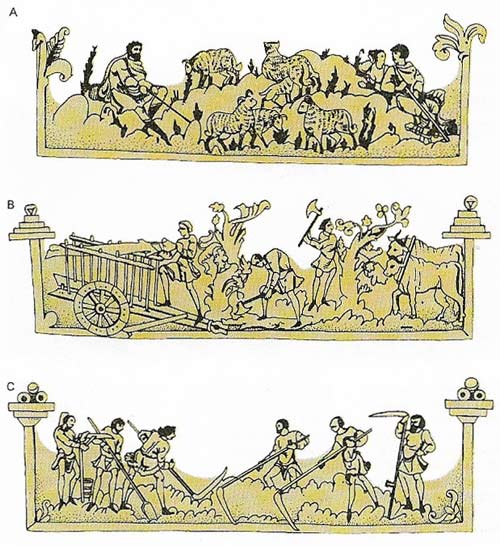
Figure 3. Illustrated calendars of seasonal activities provide the best visual evidence of medieval costume and methods of agriculture. Shown here are May: a shepherd and his flock (A); June: cutting wood (B) and July: haymaking (C).
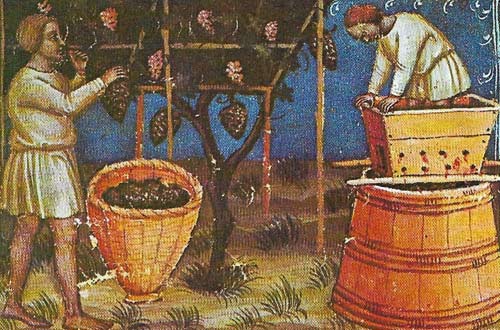
Figure 4. The grape harvest depicting in an Italian calendar shows the method of pressing the grapes with the feet, a tradition that survived in parts of rural Italy until after 1945. Wine was produced in quantity throughout Southern Europe, in most of France and on the Rhine and Moselle areas of Germany. Production methods had changed little since the days of the great Roman villas and viticulture was, throughout the Middle Ages, still the economic prerogative of the big landowner or entrepreneur. By the 13th century a genuinely international wine trade had developed along a north-south axis with large quantities of wine being shipped in barrels by water transport.
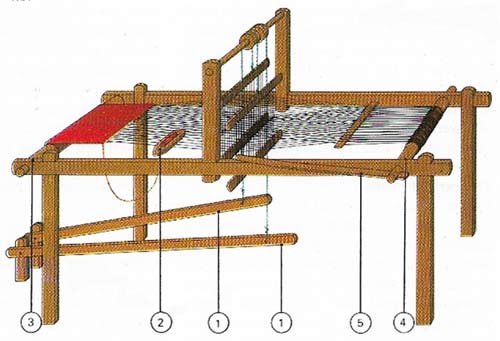
Figure 5. Horizontal treadle looms, introduced in the 13th century, stimulated textile manufacture, the medieval industry that employed most urban craftsmen, the less efficient vertical loom was replaced by a machine using treadles (1) to raise or lower the lengthwise threads as the shuttle (2) passed through them. Cloth was wound on to the cloth beam (3) as thread was released from the warp beam (4) by depressing a lever (5). About two-thirds of all trade was in cloth or raw materials required for it. Most fearing was done in the Low Countries, partly by urban industry and partly by cottage labor.
Between 1000 and 1250 the economic foundation of Europe shifted to the north. The new wealth came from a rapidly developing agriculture in the northern European plain between the Loire and the Elbe. Under the Romans this had been a sparsely populated forest area; now as a result of expansion, it was the Mediterranean that became a frontier zone.
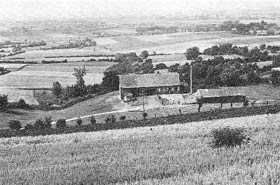 |
| Drainage and land reclamation was one of the most spectacular aspects of the clearing of the northern European plain in the 11th and 12th centuries. An area near St Omer in France shows how, in the early Middle Ages, polders were diked, marshy land made fit for grazing and a system of waterways constructed. Cultivation of new lands both fed a larger population and gave greater freedom to farmers, who paid for pioneer lands in fees rather than in services: two vital factors for commercial and industrial expansion of Low Countries during this period. |
An era of expansion
In this new world all the energy and enterprise of the pioneer was yoked to clearing the forests, establishing villages, and marking out the routes, largely independent of the Roman system, that bound the plain together. Here and there the directing force of some powerful family or monastic community could be detected, but almost certainly most of the work was done by small family groups and peasant communities. In the progressive draining of the marshes of Lincolnshire, Flanders, and the Po basin – among the most remarkable achievements of these centuries – the lead may have been given by abbeys such as Ramsey or Les Dunes, but the fiercely independent spirit of the subsequent peasant proprietors suggests that many took matters into their own hands and proceeded to drain the land themselves.
Intensive settlement of the soil implies an increasing population. In this period, without records of taxation, there is no direct evidence to measure population growth; but an indication that numbers increased rapidly comes from the 12th-century migrations of both peasants and knights from France, Germany and Flanders to Eastern Europe, Spain, Sicily and Palestine.
Within the bounds of Western Europe the few surviving monastic estate documents give glimpses of the slow development of a farming expertise geared specifically to northern climates, such as the use of the heavy-wheeled plough (carruca), the harnessing of draught animals in columns and the development of the watermill for grinding corn, which gradually came into use between 1000 and 1250. By 1200, horses were shod and harnessed with a shoulder collar. More had, by then, been learnt about spring and autumn crops: wheat and rye for standard autumn-sown cereals, but other varieties for the more rigorous climates. The use of spring-sown oats and barley for poorer soils was understood by progressive estate managers of the thirteenth century, such as the agricultural writer Walter of Henley.
Social and economic organization
The social structure of this developing agrarian society is difficult to determine and probably varied dramatically from area to area. Where seigneurial and monastic land-lords. took an interest in developing their lands (and many did, especially the new order of Cistercian monks), it was common to attract landless labourers with the promise of heritable tenures, on condition that they bound themselves and their heirs to the soil. Serfdom was one way of organizing labour for cooperative work, but it is a mistake to see it as universal. The peasant "communes" of the open-field system in France and England, with their periodic redistribution of holdings, the independent holdings (allods) of Aquitaine and the farmsteads (casalia) of Italy all resulted from peculiarities of local custom and circumstance. What is reasonably certain is that the number of such communities increased sharply during the eleventh and twelfth centuries.
The rise of towns
The other consequence of population increase was the growing importance of towns as centres both of exchange and production. The origins of towns varied, but most of them grew up to serve local needs, as strongpoints (the burg) to which agricultural markets were attached, or as ports importing and exporting goods. The more intensive the settlement of the land, the larger and more numerous were the towns. The number of cities in Flanders and northeastern France – Bruges, Arras, Valenciennes, and others – reflects a high agricultural population. The burgeoning cloth production of Bruges in the twelfth century, in part depended on the farming of sheep in the Flemish salt marshes. The towns' specialized way of life needed independent institutions: the earliest guild of merchants known, that of Tiel in Holland, existed earlier than 1000, but the merchant guild as an instrument of communal government became common only in the twelfth century. The towns flourished, however, because of the vast consumer market that had developed by 1200.
By 1000 Western Europe was in sporadic but persistent contact with the East through the Baltic and Russia, and with the decline of Saracen piracy in the Mediterranean the Italian ports developed strong links with Egypt and (after 1098) the Crusading states, which enabled Oriental silks and spices to reach the West. Mediterranean trade (Figure 1), necessarily large-scale and risky since goods bought abroad were never pre-sold, gradually led Venetian merchants to develop a "capitalist" system of investment (Figure 2).
The High Middle Ages was a period of almost universal expansion in Western Europe, an underdeveloped continent ready for sustained exploitation. As conditions changed, however, the warning signs of overpopulation and overuse of the land went unnoticed until persistent famine and plague swept over the region brought a general recession in the 14th century.
